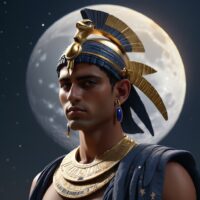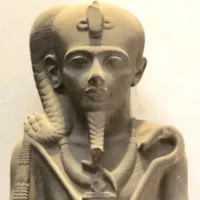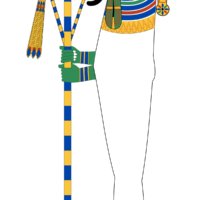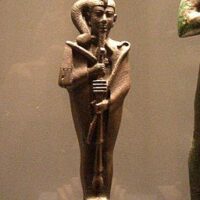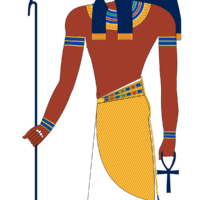Khonsu : The Moon God
Listen
At a glance
| Description | |
|---|---|
| Origin | Egyptian Mythology |
| Classification | Gods |
| Family Members | Amun (Father), Mut (Mother) |
| Region | Egypt |
| Associated With | Moon |
Khonsu
Introduction
Khonsu, often portrayed as a young man or a falcon-headed deity, is a key figure in Egyptian mythology. As the god of the moon, time, and healing, his significance reaches beyond his celestial role. His name, meaning “traveler,” signifies his journey across the night sky. Ancient texts, temples, and artifacts underscore his importance in the religious and cultural life of ancient Egypt. Khonsu, the enigmatic moon god, has intrigued people for millennia with his association with the night sky, time, creation, and protection. Alongside Thoth, he played a crucial role in marking the passage of time.
Physical Traits
Khonsu is often depicted as a young man with a sidelock of youth, symbolizing his vigor and vitality. He commonly wears a headdress featuring a crescent moon and a full lunar disk, highlighting his lunar connection. In some portrayals, Khonsu has the head of a falcon, drawing a parallel to Horus, another prominent Egyptian deity. His traditional attire includes the shendyt kilt and a was-scepter, symbolizing power and authority. Occasionally, a uraeus (royal serpent) is seen on his forehead, representing royalty and divine power.
In different artistic contexts, Khonsu might appear as a youthful figure adorned with a simple kilt or in a more regal manner, wearing a long white robe and elaborate jewelry. Some depictions present him as a mummy, reflecting his role in the afterlife and the Egyptian focus on the cycle of death and rebirth. This mummified form, coupled with the sidelock of youth, links him to other divine children like Horus and Shu. His falcon-headed portrayal and association with the moon disk and crescent moon underscore his protective and healing aspects.
Family
Khonsu held a significant role within the Egyptian pantheon as part of the Theban Triad, a revered family unit in Thebes. His parents, Amun, the king of the gods, and Mut, the goddess of motherhood and creation, positioned Khonsu among the foremost deities in Egyptian religion. He was worshipped alongside Amun and Mut in grand temples, most notably in the Temple of Karnak, where a substantial section was dedicated to his veneration. This divine lineage and familial association with Amun and Mut elevated Khonsu’s status, linking him to some of the most powerful and influential gods in Egyptian mythology.
Other names
Khonsu is revered under various names and epithets, each emphasizing different facets of his character and influence. Known as “Khonsu Neferhotep,” meaning “Khonsu the Good,” and “Khonsu Pa-ir-sekher,” translating to “Khonsu the Child,” he embodies both benevolence and youthful vigor. Additionally, his title “Khonsu-in-Thebes” highlights his significant worship in the city of Thebes. His primary name, meaning “The Traveler,” underscores his connection to the moon’s nightly journey across the sky, symbolizing his role in navigating the heavens.
Beyond his lunar association, Khonsu held numerous titles that showcased his diverse powers. As the **Embracer**, he was perceived as a protector of travelers under the night sky. His title **Pathfinder** linked him to the concept of timekeeping through the moon’s journey, making him a guide through both literal and metaphorical darkness. As the **Defender**, Egyptians believed he warded off evil spirits and safeguarded them from nighttime dangers. His role as a **Healer** connected him to rebirth and fertility, particularly in the context of childbirth, demonstrating his association with health and well-being.
These various titles and names paint a comprehensive picture of Khonsu’s multifaceted nature. He was not merely a moon god but also a protector, guide, healer, and a symbol of time’s passage. His significance is further illustrated by alternative names such as Chonsu, Khensu, Khons, Chons, or Khonshu, reflecting the rich and complex identity he held within Egyptian mythology. Each epithet and title encapsulates a different aspect of his divine role, contributing to his enduring legacy in the religious and cultural history of ancient Egypt.
Powers and Abilities
Khonsu’s divine prowess stems primarily from his association with the moon, endowing him with a wide array of powers and attributes. As the god of the moon, he holds sway over time, overseeing the lunar phases and the progression of months. His influence extends beyond temporal matters, as he is also revered for his healing capabilities and protective instincts. Ancient texts abound with accounts of Khonsu’s miraculous interventions, credited with curing ailments and safeguarding against malevolent forces. From warding off evil spirits to ensuring fertility and prosperity, Khonsu’s domain encompasses various facets of life, making him a pivotal figure in the religious landscape of ancient Egypt.
The aspect of Khonsu as a healer holds particular prominence, with devotees seeking his aid for a myriad of medical afflictions. His reputation as “Khonsu the Healer” inspired widespread veneration, with rituals and amulets dedicated to invoking his divine intervention. In the intricate tapestry of ancient Egyptian culture, where religion interwove with medicine, Khonsu’s healing prowess was revered as a potent force against illness and malevolent influences. His association with fertility, coupled with his protective mantle, positioned Khonsu as a guardian of life and well-being, revered for his benevolent presence in both the seen and unseen realms.
Furthermore, Khonsu’s lunar connection underscores his significance in the broader cosmic order. Believed to influence fertility, growth, and new beginnings, Khonsu was entreated for blessings in conception and agricultural abundance. Alongside Thoth, he played a pivotal role in measuring time and marking its passage, anchoring the Egyptian understanding of temporal cycles. His association with the night sky not only imbued him with protective qualities against nocturnal dangers but also linked him to the unseen world, where his divine light shone as a beacon of hope and guidance for those seeking solace and security.
Modern Day Influence
Khonsu’s legacy persists in contemporary society, captivating imaginations through the enduring allure of ancient Egyptian mythology and culture. His iconic representations and symbols permeate various forms of modern media, from literature and art to the realms of films and video games. Khonsu’s association with the moon and his renowned healing abilities render him a compelling figure in present-day narratives, often depicted as a symbol of mystical protection and power. Within modern spiritual and neo-pagan circles, Khonsu occasionally garners reverence as a deity embodying lunar influence and healing energies, reflecting a continued admiration for his ancient attributes. Furthermore, Khonsu’s role in timekeeping and lunar cycles finds resonance in contemporary astrological practices, where the phases of the moon remain significant markers.
The preservation of Khonsu’s legacy extends to the ongoing study and safeguarding of ancient Egyptian artifacts and temples, ensuring that his worship and the broader religious practices of the time are not forgotten. The Temple of Khonsu at Karnak stands as a testament to this, with its magnificent architecture and inscriptions serving as a focal point for scholars and tourists alike, eager to delve into Egypt’s rich cultural heritage. Khonsu’s imagery and symbolism also permeate modern jewelry and fashion trends, with motifs such as the crescent moon and lunar disk drawing on ancient Egyptian aesthetics to blend historical reverence with contemporary style. Despite the decline of direct worship, Khonsu’s influence continues to resonate in multifaceted ways, bridging the ancient past with the present.
In modern popular culture, Khonsu experiences a resurgence of interest, appearing in various forms of entertainment like comic books, video games, and television shows, often retaining his core attributes as a moon deity associated with protection and healing. Additionally, Khonsu’s name has been immortalized in astronomical contexts, such as designating celestial features like a crater on the moon, underscoring the enduring connection between the moon god and the celestial realm. As a symbol of new beginnings and the cyclical nature of life, Khonsu remains an ever-present reminder of the eternal passage of time, leaving an indelible mark on contemporary culture.
Related Images
Frequently Asked Questions
What is lorem Ipsum?
I am text block. Click edit button to change this text. Lorem ipsum dolor sit amet, consectetur adipiscing elit. Ut elit tellus, luctus nec ullamcorper mattis, pulvinar dapibus leo.
What is lorem Ipsum?
I am text block. Click edit button to change this text. Lorem ipsum dolor sit amet, consectetur adipiscing elit. Ut elit tellus, luctus nec ullamcorper mattis, pulvinar dapibus leo.
What is lorem Ipsum?
I am text block. Click edit button to change this text. Lorem ipsum dolor sit amet, consectetur adipiscing elit. Ut elit tellus, luctus nec ullamcorper mattis, pulvinar dapibus leo.
What is lorem Ipsum?
I am text block. Click edit button to change this text. Lorem ipsum dolor sit amet, consectetur adipiscing elit. Ut elit tellus, luctus nec ullamcorper mattis, pulvinar dapibus leo.
What is lorem Ipsum?
I am text block. Click edit button to change this text. Lorem ipsum dolor sit amet, consectetur adipiscing elit. Ut elit tellus, luctus nec ullamcorper mattis, pulvinar dapibus leo.

